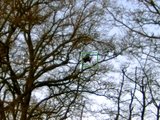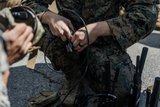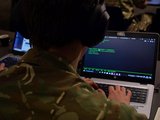Australia looks towards space with force restructure, investment and training
Australia is looking to improve its presence in space with a focus on communications and creating a dedicated segment of its defence forces committed to the domain.
Northrop Grumman (NG) introduced its Heterogeneous Airborne Reconnaissance Team (HART) solution to the European market at DSEi on 13 September.
According to Tim Beard, deputy director for advanced concepts at NG, HART answers the needs of ground forces conducting operations with airborne ISR systems.'The issue is that there are lots of UAVs in the air but no-one has created a system with all those so we can share the data and take advantage of all the ISR being generated in the field,' he explained.
Run in collaboration with DARPA, the HART programme has already conducted field tests with the US Army and US Marine Corps (USMC). Beard described a series of supercomputers capable of processing data from multiple UAVs, geo-registering it and disseminating back to warfighters on the ground via personal display units.
'Small unit leaders in complex environments have limited real-time RSTA services. Tasking, re-tasking and sensor to shooter timelines are too long, unless they own their own UAV,' he continued.
To date, 10 different types of UAV have been integrated to operate in the HART concept of operations. These include Shadow, Raven, Scan Eagle and Wasp as well as the Huron ARMS fixed wing asset. Beard added that Gray Eagle, Fire Scout and Global Hawk platforms were currently being integrated into the system.
In total, HART can accommodate over 50 air vehicles that can be tapped into by 50 users, although this would involve a queueing system, Beard conceded. The system is capable of managing and deconflicting airspace movements. Warfighters are also able to annotate and share video data with other dismounted users.
'[HART] is a platform agnostic solution that enables direct access to actionable intelligence via a system of existing UAS, sensors and networks. It disseminates geo-registered video to small unit leaders via handhelds and to TOCs via visual displays. It can also manage bandwidth to whatever system a soldier has in the field,' Beard said.
The system works in conjunction with the HART C3 Center, designed for operations within a TOC. This, Beard described, included a general purpose computer for long term planning which can manage allocated airspace as well as manage service requests and product delivery to warfighters.
In addition, HART can also be networked to the Mobile Ground Control Station or Portable Air Vehicle Image Exploitation Supercomputer.
Referring back to ongoing developments with the US Army and USMC, Beard said both services were looking to undergo additional test exercises in 2012. In March this year, the army and DARPA conducted an operational capability demonstration at Dugway, Utah. The USMC has also run exercises in Quantico, Virginia and Twenty-Nine Palms in California.

Australia is looking to improve its presence in space with a focus on communications and creating a dedicated segment of its defence forces committed to the domain.

The Portuguese company’s naval communications system is in service across more than a dozen countries. It has turned to its home nation for support in developing a new vehicle based C2 system.

The Vision4ce Deep Embedded Feature Tracking (DEFT) technology software is designed to process video and images by blending traditional computer vision with artificial intelligence (AI) algorithms to present actionable information from complex environments.

Persistent Systems has been cleared by National Security Agency (NSA) to transmit sensitive data on commercial networks. The devices are added to the NSA’s Commercial Solutions for Classified (CSfC) component list which also includes other companies’ products providing the same security.

The release of the UK’s Strategic Defence Review (SDR) has been long promised as mid-year. It is possible it could be as early as 2 June although the UK Ministry of Defence (MoD) continues to play its cards close to its chest.

Intelsat outlines how its multi-orbit SATCOM architecture is enhancing connectivity and resilience for special operations forces operating in degraded and contested environments.